By John Shand, Harriet Cunningham, Peter McCallum, Chantal Nguyen and Cassie Tongue
CLASSICAL MUSIC
Sydney Festival. Temperament. The Nielson, Pier 2/3 Walsh Bay. January 23- 27.
REVIEWED BY: Peter McCallum
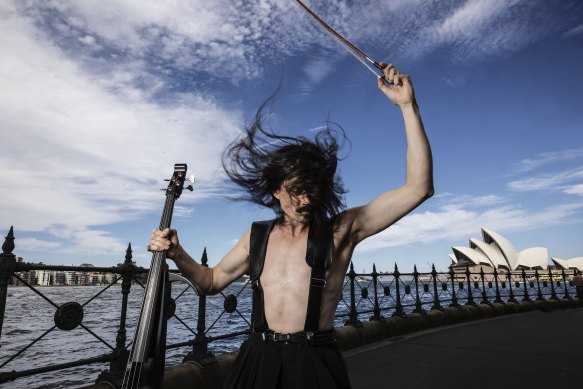
Musician Benjamin Skepper performs his hommage to Bach at the Sydney Festival.Credit: Jessica Hromas
Johann Sebastian Bach appeared in Temperament, a six-day festival within the Sydney Festival devoted to his legacy, in performance and in transcription, on original instruments and digital devices, as icon and as partner to iconoclasts. His presence loomed as spiritual and musical progenitor, while his works were both a welcome point of arrival and an inspiring point of departure.
Bach Akademie Australia, under director Madeleine Easton with a quartet of fine singers and chamber-sized ensemble, began the series of one-hour concerts with an early cantata, Actus Tragicus, and contributed a joyous performance of the motet Lobet den Herrn. A highlight was Hannah Fraser’s smooth warmth and gracefully shaped line in the Cantata “Am Abend aber dessilbigen Sabbats” and Susannah Lawergren’s brightly coloured soprano sound in duets.
On Wednesday, Young Turkish pianist Korkmaz Can Saglam, People’s Choice winner of the 2023 Sydney International Piano Competition, portrayed Bach as a foundation stone of 19th and 20th century pianism with a rewardingly transparent performance of Liszt’s transcription of Bach’s G minor organ fugue.
After two imaginatively contrasted Preludes and Fugues by Shostakovich, he gave a musically graceful account of Bach’s Partita in B flat and an unpretentious but poetic reading of the last 12 Preludes by Chopin. On Thursday, a quartet for the Australian Chamber Orchestra, Ike See, Aiko Goto, Elizabeth Woolnough and Melissa Barnard, juxtaposed Bach arrangements (including one by Mozart) with distinctive Bach homages by Caroline Shaw, Elena Kats-Chernin, Sofia Gubaidulina and Felix Mendelssohn.
Shaw’s Punctum fragments and distresses Bach’s Passion chorale, Kats-Chernin’s Re-Inventions No. 1 soars spiritedly on Bach’s Two-Part Invention in F and Gubaidulina’s Reflections on the Theme B-A-C-H uses that motto as symbol of cultural strength amid catastrophe.
Actor Ariadne Sgouros accompanied them with an evocative sketch of the global diaspora of Bach’s spirit from Auschwitz to the Arrernte people of Central Australia and the remarkable Ntaria (or Hermannsburg) Choir. On Saturday Painter Silvere Jarrosson used individual movements by Bach, played and sung by members of the Brandenburg Orchestra, as stimulus for a remarkable performance painting in which he poured, blended and dripped sensuously thick layers of paint to create marbled, feathered textures, often creating a bold shape only to completely overlay it with something else. The relationship to the music performed was not always clear to the observer, a palimpsest of hidden inspirations.
In his Praeludium y Fuga, cellist Benjamin Skepper played the piano, and then electric cello against an electronic background of distant cries, howling wind, ominous heartbeats and metallic shrieks. His playing was at times frenetic and overwhelmed, hacking the strings with the bow like a bread-knife while elsewhere he reverted to simple, even over-simple tonal ideas, using familiar and exotic scales, hymns and folk material.
I did not hear Andrew Bukenya’s Bach in Colour, which explored Bach’s predecessors and musical progeny including gospel, pop and jazz, or Ensemble Apex who, after George Crumb’s nightmarish Black Angels, ended with the unfinished final Contrapunctus of Bach’s Art of Fugue, cut off by the composer’s death just as he was about to brings its four themes to masterful combination. There was variety, imagination and reverence in this series, and some of the performances achieved moments of the luminosity one always seeks in Bach.
Korkmaz Can Saglam appears with Piano Plus on January 30 in Canberra and January 31 at Melbourne Recital Centre.
THEATRE
Saplings, ATYP
January 25, Until Feb 4
Reviewed by HARRIET CUNNINGHAM
★★★★
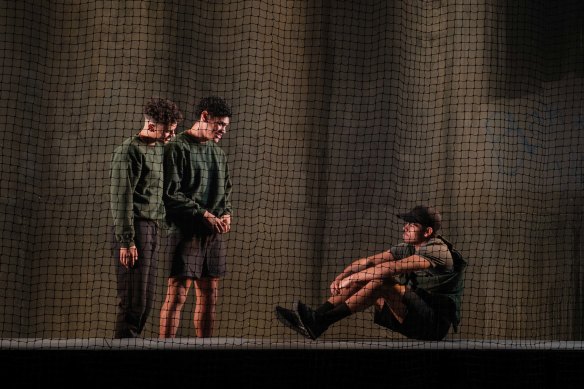
The cast of the ATYP’s Saplings.Credit: ATYP
Saplings is a new play by Yuwaalaraay playwright Hannah Belanszky and Kalkadoon director Abbie-lee Lewis, in collaboration with the Australian Theatre for Young People and Youth Action, NSW’s peak body representing young people and the services that support them. Developed from a series of workshops with participants from across NSW, it has the feel of verbatim theatre, albeit carefully and respectfully crafted into a linked series of snapshots depicting scenes from the life of people under supervision in the youth justice system.
‘Supervision’, as Saplings portrays, is a many-hued word: we see Maliyan Blair and Nyasha Ogden stuck in the Groundhog Day grind of days spent in waiting rooms, waiting for bail, waiting for court, waiting for sentencing. Ioane Su’ala paints the picture of home detention, with an AVO kicker, in a house with paper thin walls and no food. A broad mesh curtain transforms the stage into a detention facility where two boys try to defuse the explosive rage of their friend. Then there’s a complete lack of supervision: Maliyan Blair and Wesley Patten’s opening scene portrays two bored, brilliant saplings, tossing up their options. Watch TV? No, the electricity’s been cut off. Go down the creek, buy lollies at the servo, moon the truck drivers? Or start a music duo, make a million on YouTube, and pay mum’s electricity bill? That’s the one. But first, they need a smartphone to record their song, and – guess what? – there’s no phone.
The cast, as Lewis comments in her program introduction, embodies the reality of youth justice today: of the nearly 5000 people aged from 10-17 who are in ‘supervision’ on any given day in Australia, the majority are male, and a disproportionate number are Indigenous*. But whereas the numbers and jargon like the expansive term ‘supervision’ dehumanise the situation, the four actors Maliyan Blair, Nyasha Ogden, Ioane Sa’ula and Wesley Patten bring it to life. Meanwhile, Belanszky’s script stitches together the complexities of the system into a delicate story of challenge and possibility.
This might sound like a tough night in the theatre but it is anything but. Humour, often self-deprecating, is never far from the surface, and so is ingenuity and resilience, expressed in quick fire backchat and physicality. The words fly past. Catch ’em if you can.
*Youth Justice in Australia, 2021-22
DANCE
Skid & SAABA by GöteborgsOperans Danskompani
Roslyn Packer Theatre, January 23
Until January 28
Reviewed by CHANTAL NGUYEN
★★★★
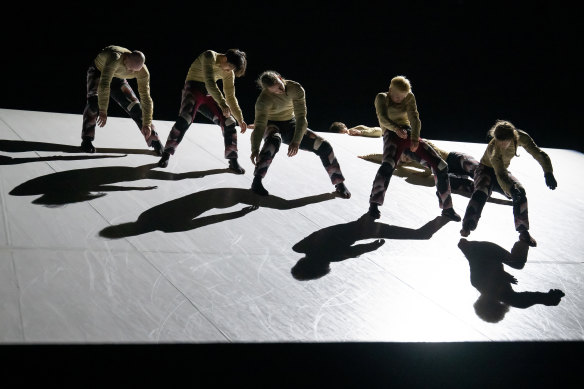
Skid, by Belgian and French choreographer Damien Jalet from the GöteborgsOperans Danskompani where 17 dancers perform on a 34-degree sloped stage.Credit: Wolter Peeters
The best of Scandi dance lands in Sydney this summer with Sweden’s stunning GöteborgsOperans Danskompani, one of Europe’s foremost contemporary dance companies.
Hitting up the Sydney Festival with a winning double bill, their first dance is Skid, a frequently-toured smash hit by French-Belgian choreographer Damien Jalet.
Skid is performed on what looks like an icy ski slope – a giant, shining white stage tilted steeply at 34 degrees. Its opening is hypnotically meditative, with dancers gracefully tumbling down the slope in increasingly complex configurations. They’re all wearing tabby boots: ninja-style shoes with rubber soles and split toes that allows them to nimbly manage the steep incline.
There’s something deeply absorbing about observing dancers at this unusual, tilted angle: you feel you have all the panoramic distance of a bird flying over a vast, glacial lake.
Skid then switches gear with a thumping industrial soundtrack and a costume change to black and red futuristic military jackets. The dancers begin – astoundingly – moving up the slope in a sharp, determined progression like ranks of soldier cyborgs: inhumanly strong, single-minded, unstoppable.
Skid then closes with a beautifully contrasting nod to human frailty and the cycle of life. It’s gorgeous choreography, heart-stopping athleticism, and deeply touching drama all at once – I can’t recommend it highly enough.
Next comes SAABA by Israeli-French choreographer Sharon Eyal. Her work is currently “flavour of the month” in European circles, but SAABA is ultimately disappointing.
It serves up its main aesthetic concept right from the start: the dancers remain almost always on tip-toe, picking up their feet as if tottering down a runway in sky-high stilettos. And it’s undeniably slick, with a sexy soundtrack, moody lighting, and choreography that’s heavy on pouts, artily contorted limbs, and contracting torsos. The costumes (designed by Dior creative director Maria Grazia Chiuri) are also undeniably stunning – a clever lacy subversion of the usual nude-coloured contemporary dancewear.
But underneath its slick, predictably sexy façade, Eyal’s choreography gets repetitive, failing to exploit the full range of the dancers’ astounding technique. While SAABA’s aesthetics are undeniably high end, the best dance resonates at a deep emotional level and challenges you intellectually. In those departments, SAABA leaves you feeling criminally underfed. It’s worth a look for the costumes and stunning dancers. Ultimately though, the experience feels like you’ve stumbled into a high-end bar overrun with sexy-but-distant fashion models, who take your order but never bring you the drinks.
CABARET
Rizo: Prizmatism, Wharf Theatres
Until January 27 ★★★★
Reviewed by CASSIE TONGUE
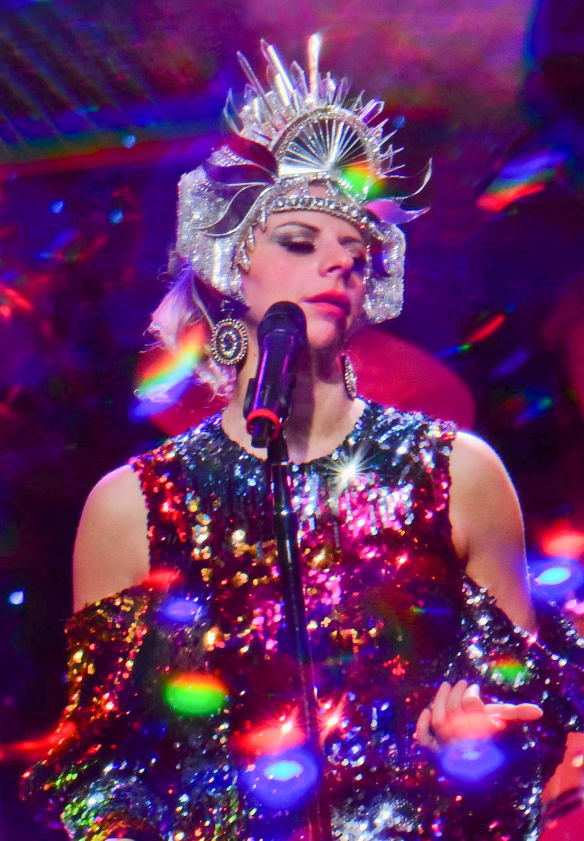
Rizo in Prizmatism.Credit: Sydney Festival
Many arts and culture lovers draw the line at attending cabaret. Cabarets are often personal, confessional, and emotional. It’s vulnerable, and that can be confronting. But sometimes, confronting is good. Cabaret can be political, joyful, and challenging. Sometimes, it’s cathartic.
For joy and catharsis, why not start or continue your cabaret journey with Rizo: Prizmatism? Rizo is Amelia Zirin-Brown, the American cabaret star who last played Sydney Festival in 2018. She’s invested in the exchange of energy between artist and audience, that spark that makes live performance, at its best, not just irresistible but essential.
She welcomes us ‘home’ – that’s the space inside her arms – and offers up the 70-minute show as a place to let down the burdens we carry. She encourages light call-and-response singing; she urges us to cheer or let out a ‘huzzah’ if we enjoy her performance (and then leads a group huzzah so we can all have the pleasure of saying it). She slow-dances with an audience member. Later, she has us doing choreography.
But there’s no need to be self-conscious. These interactions only work if we’re all in it together, and Rizo brings us on board. The show is clearly born out of pandemic-related processing; Rizo talks about identity and performance and how losing the latter in shutdowns impacted the former.
She’s eager to connect. More than once, she describes humans as ‘deeply communal’; we benefit from being together, she says, beating as one heart. This idea collapses into, or gives way to, the idea of prisms, Rizo self-reckoning with the many versions of herself, landing now at the uncomfortable label of ‘middle-aged,’ to discover truths about herself and the world.
Do these pieces fit neatly together? Not quite. Does it matter, though, when she’s singing ‘Love for Sale’, or when we’re trying to turn a song into witchcraft by gently joining in? Does a journey have to be linear when it’s this gorgeously sung? And it is gorgeous, make no mistake, all of it: Rizo can hold a note in the air like it’s tangible, and an audience in the palm of her hand.
This is the magic of cabaret you might be missing out on: for about an hour, a group of people suddenly have something in common. We’re all in one place, experiencing the same beauty, and laying our burdens down just long enough to remember what it’s like to feel light again.
Soliloquy
Genevieve Lacey and Gideon Obarzanek
City Recital Hall, January 17
Reviewed by PETER McCALLUM
★★½
Recorder player Genevieve Lacey sat on a tiered stage bathed in pale light, eyes closed, playing Telemann’s first Fantasia for solo flute as though no-one was watching. Lacey’s tone is quietly golden and her rhythm free, and she followed Telemann’s changeable directions in the first movement of the first Fantasia with dream-like whimsy.
For the second Fantasia in A minor, she was joined by dancer Stephanie Lake, who lay on her back and performed an elegant dance of fluid gestures and elegant shapes for hands alone. For the third Fantasie, Lake danced from standing position and, for the fourth, an ensemble of 20 to 30 entered quietly through the audience to occupy the tiers on either side of Lacey and Lake.
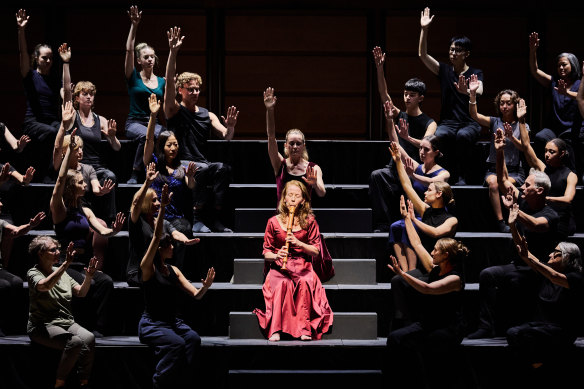
Genevieve Lacey with the volunteer participants in Soliloquy.Credit: Victor Frankowski
These performers were a group of untrained participants invited to co-create a communal “music-dance ritual”. Lake quietly gave instructions to those sitting closest to her and these were passed down the rows with a quiet nod.
Their first contribution was a group version of the hand dance. Led by Lake, seated and facing the audience, their softly lit arms created a forest of undulating willowy limbs. For the fifth Fantasy, Lake crouched behind Lacey for another hand and arm dance, turning the recorder player into a Shiva-like figure with an extra pair of arms that amplified and embellished Lacey’s playing, which was almost unmetered at times.
The performance continued for all 12 of Telemann’s Fantasias, each exploring a different configuration co-planned with choreographer Gideon Obarzanek. For one, the untrained participants danced at the front of the stage the way people do at parties, for another they lay somnolent on the tiers and for another processed around the stage area or marched.
The twelfth Fantasia recapitulated the opening in reverse, first with a hand dance from Lake and then Lacey alone as they walked off. For me, it maintained interest until about the fifth Fantasia, after which the ideas palled. The Fantasias themselves are suites of Baroque movements, inviting a free performance style and Lacey’s manner of playing without fixed rhythmic framework tended to blend them into a continuum without strong differentiation.
Soliloquy, the program stated “subverts the hierarchy of traditional concert music” by mixing trained and untrained performers. The untrained performers concentrated attentively, but there nevertheless remained a strong audience/performer divide. Coming 60 or more years after John Cage’s iconoclasm, it was, as subversions go, quite tame. Fortunately, it won’t put trained performers out of a job.
THEATRE
ARE WE NOT DRAWN ONWARD TO NEW ERA
Roslyn Packer Theatre, January 16
Until January 20
Reviewed by JOHN SHAND
★★★★
Here was something to bend the brain and fire off the synapses like so many New Year’s Eve crackers. This was theatre as spectacle, magic, image, poetry, didacticism and even cinema.
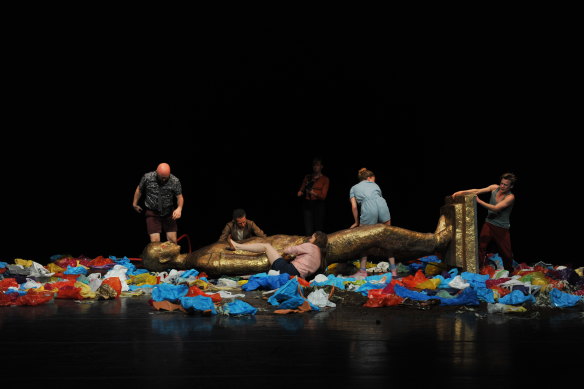
The plastic bags have an aesthetic impact akin to a bed of flowers.Credit: Mirjam Devriendt
To ask what it’s about is both the right and the wrong question. It’s the wrong question because, while its creators may not see it this way, for me, its essence is not its subject. For it to be a succession of extraordinary images is enough, and meaning need not be imposed upon them.
It’s certainly more than enough to be reduced or exalted to a state of wonderment, rather like when you were little, and saw for the first time a beach, a cat, a fire hydrant, a worm or a waterfall. It can be sufficient that such things simply are, without questioning why.
It’s also the right question because the creators have strived to ensure you do ponder its meaning. The title, Are we not drawn onward to new erA, is a palindrome, and the piece itself is structurally and narratively palindromic. Specifically, it’s about what we’ve done to the planet and how we could undo it, encapsulated in 75 minutes.
It begins with a couple, an apple and a tree, minus the snake. Subsequently, the tree is destroyed, and hundreds of brightly coloured plastic bags stream from the flies. I’ve never seen plastic bags look so beautiful; never thought they could have an aesthetic impact akin to a bed of flowers.
Then a giant bronze-coloured statue is dragged on in pieces, and once it’s erected we see it’s not a general or a politician, but a youth in jeans and t-shirt; one of us, if you like because ultimately “we” make history just as much as do the so-called eminent. When the statue is engulfed in dry ice, we’ve reached the half-way mark, whereupon these events all start happening backwards, or forwards, depending on your point of view. But we’ll come to that.
Devised by Belgium’s Ontroerend Goed company, the show is directed by Alexander Devriendt, with dramaturgy by Jan Murtens and scenography by Philip Aguirre. Its six actors communicate more with movement than words, and when they do speak, it’s initially in a backwards gobbledegook that becomes intelligible later. A particular joy is the music: William Basinski’s Disintegration Loops, recorded by Spectra Ensemble, which is equally disquieting and entrancing.
The disquieting part of the show is the implication of us standing on the precipice of our own destruction via climate change, and still doing too little to avert catastrophe. As important as it is, the message – “We can’t undo what we did. We can only move forward one step at a time” – is so overtly preachy as to intrude on the prevailing visual poetry, rather than being thoroughly interwoven.
Of just as much interest are the more general philosophical implications of our capacity to undo what we have done. On an obvious level, this applies to our ability to reverse climate change, but it also applies on a micro level to our capacity to counter the wrongs we have done to others; to redress the hurt of our words and actions. The show has deep roots in this regard.
As for how it travels backwards? I was fibbing. I shan’t give that away. You’ll just have to see it. You won’t forget it.
Ode to Joy (How Gordon got to go to the Nasty Pig Party)
Neilson Nutshell
January 16
Until January 21
Reviewed by Harriet Cunningham
★★★★
Gordon is a public servant who works in the legal department of the Scottish government. Marcus runs a gym. Tom works from home. He has an Etsy store. Marcus and Tom are married. Gordon wears sensible slacks and a lanyard with his name tag.
Marcus wears a harness beneath his teeny tiny orange trackies and answers to the name of Cumpig. Tom wears a yellow-and-black plaid kilt over his latex undergarments and prefers to be called Manpussy. If this is too much information for you, stop reading now.
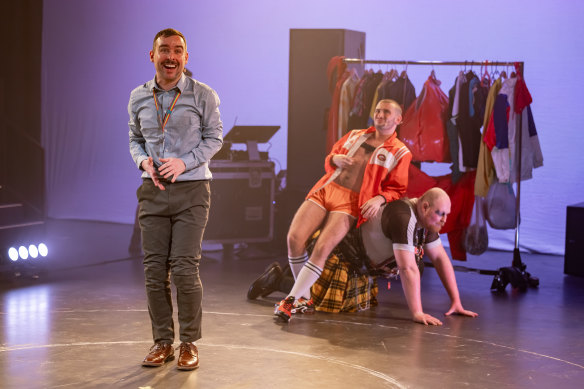
Lawrence Boothman, as Gordon, transforms, Cinderella-like, from a straight-laced policy wonk into an insatiable party animal.Credit: Jacquie Manning
Writer/director James Ley’s exuberant Ode to Joy (How Gordon got to go to the Nasty Pig Party) revels in too much information. The program even includes a glossary of gay, in case you don’t quite catch the details as they flash by. Which is very helpful, because the music is loud, the accents are thick and things move fast in the world of Pig Play*.
The magnificent Marc MacKinnon, as Manpussy/Tom, marshalls the action, propelling his colleagues through the story of how the three of them met, fell in love, had sex, went to Berlin, had more sex, found themselves, found each other and found joy. Along the way he indulges us with a show-stopping outbreak of Riverdancing and models a splendid lifejacket and swimwear inspired party gown (with a nod to costume designer Cleo Rose McCabe).
Sean Connor, as Cumpig/Marcus, is a charismatic, coiled spring of sexual energy. Meanwhile, Lawrence Boothman, as Gordon, transforms, Cinderella-like, from a straight-laced policy wonk into an insatiable party animal, much to the glee of his ugly brothers. Along the way they bounce off the walls of Edinburgh gay culture, Brexit and the Scottish independence movement, capturing a moment in time with piercing insight.
It’s loud, it’s out there, it’s outrageous. It’s very, very funny and it’s even, at moments, quite moving. It may be a little much for some but it’s hard not to fall in love with all three characters, and to cheer them on as they find untrammelled joy in the strangest of places.
Find out the next TV, streaming series and movies to add to your must-sees. Get The Watchlist delivered every Thursday.